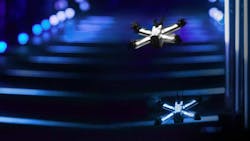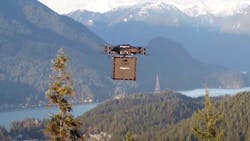Racing Drones for Fun and Profit
What you’ll learn
- What’s up with the Drone Racing League.
- What is the difference between a racing drone and a regular drone?
- How Draganfly has developed a “safe and sustainable” drone solution.
Drones are incredibly versatile. In addition to providing effective and sustainable solutions to a number of industries, unmanned aerial vehicles (UAVs) also are being used for sport.
Draganfly, one of the longest-running drone companies in the world, recently announced a multi-year partnership with the Drone Racing League (DRL), which is the world's premier, professional drone racing property. DRL’s broadcasted races currently reach millions of fans around the world who love watching experienced pilots make hairpin turns through multiple gates as they navigate their drone toward the finish line.
I talked with Draganfly CEO Cameron Chell to discuss the company’s partnership with DRL and how it plans to advance the cutting-edge sport of high-speed drone racing (Fig. 1).
Why is this multi-year partnership with DRL important? How will it benefit the sport of drone racing?
This multi-year partnership is an incredible opportunity for both Draganfly and the DRL. Draganfly has been driving the future of drones since the pre-drone era and DRL is constantly driving the future of sports.
Together, we’re launching DRL Labs, which is an innovation hub focused on researching and developing next-generation drone technology that will help us advance the sport of drone racing. Draganfly and DRL engineers will search for new technical solutions within sensors, autonomy, and artificial intelligence. Then, in front of millions of fans, DRL’s globally broadcasted races will provide a real-time testing ground for the innovations created by DRL Labs.
While new drone technology will disrupt drone-racing competition and the fan experience, we will also leverage our discoveries for the good of humanity. Solutions developed by DRL Labs will be used to support other industries undergoing significant transformations through drones, including humanitarian aid and mobility. We’re excited to find new ways to help disaster relief, transportation, and delivery spaces.
DRL is built on innovation and the commitment to showcase best-in-class technology to its fans. They are creating a new era of sports by combining both e-sports and real-life competition. Draganfly is thrilled to be bringing our leadership in drone hardware, software, and logistics to DRL’s global racing circuit.
With the launch of DRL Labs, we will introduce novel drone technology that will redefine the sport of drone racing and provide real-world use cases to support communities.
What’s the difference between a racing drone and a regular drone?
What makes drones unique is their ability to quickly and effectively adapt to the needs of a specific situation. When it comes to the sport of drone racing, drones are typically smaller—around 250 mm—and they need to be fast, agile, and durable. There are a number of characteristics that separate racing drones from other UAVs.
First, racing drones are specifically designed for forward flight and have a camera positioned on the front of the chassis. Like looking through the windshield of a racecar, this camera allows DRL pilots to steer from the point of view of the drone in real-time by wearing First Person View (FPV) goggles (Fig. 2).
Accompanying the front-facing camera, racing drones use high-performance electronic speed controllers (ESCs), which modulate the amount of power that goes to the motors. This allows DRL pilots to accelerate quickly and slow down suddenly. The flight controllers used by DRL contain a straightforward hardware, with most of the performance coming from software that offers specific adjustments to perfect and tune.
Given the high-octane and adrenaline-pumping nature of drone racing, it’s crucial that the frame of a racing drone is made from sturdy, lightweight materials like carbon fiber to withstand impact. DRL races are full of split-second decisions. To cross the finish line first, pilots need to make hairpin turns and navigate multiple gates. If they hit the edge of a gate or another obstacle, a frail drone could be the difference between winning the race and not finishing at all.
While specific characteristics differentiate racing drones from other UAVs, Draganfly is dedicated to working with its partners to design and customize tailor-made solutions that fit seamlessly into their existing operations.
Our Draganflyer Commander2 is a multi-mission, high-endurance, electric, small unmanned aerial system (sUAS). It combines signature design elements of past Draganflyer systems with the most advanced features to date.
Exclusively designed, developed, and manufactured in North America, Draganfly’s patented carbon-fiber folding airframe and wide range of interchangeable payloads makes this system a must-have for capturing high-resolution imagery. The Commander2 is already being used in a number of industries, including agriculture and public safety.
The Draganfly Tango2 also is a high-endurance, dual-battery drone capable of carrying a wide array of payload systems. The aircraft utilizes Draganfly’s intelligent power-management system to extend flight times while increasing safety. We’re really proud of this ready-to-fly solution, as it is ideal for agricultural monitoring and research, mapping, surveying, environmental monitoring, as well as search and rescue.
Another drone that’s prominent in agricultural and environmental sectors is our simple and fully automated Quantix Mapper. Capable of vertical takeoff and landing (VTOL), it’s able to seamlessly transition to horizontal flight, maximizing efficiency and range. The Quantix Mapper has a 45-minute flight time and the drone’s fully automated navigation is capable of reaching 400 acres per flight.
At Draganfly, we design and manufacture professional drones for specific use cases. We work with industry leaders to understand their problems and workflows to ensure we craft the perfect solution. We only make decisions and drones we can be proud of.
When it comes to drone racing, the goal is to complete complex courses faster than the other pilots in the heat. We look forward to finding innovative ways of advancing the sport with DRL.
Are there other ways Draganfly is helping advance the sport of drone racing?
In addition to the launch of DRL Labs, the Drone Racing League incorporated Draganfly’s AI Vital Intelligence platform into the 2021-22 DRL Algorand World Championship Season.
Using existing camera systems, the platform is able to screen, with voluntary consent, temperature, blood pressure, heart rate, respiratory rate and oxygen saturation (SpO2) in seconds. Our Smart Vital system doesn’t register any personal data of the individual being screened.
Before and after the DRL Vegas Championship Race, which took place outside T-Mobile Arena during CES this year, the league’s pilots had their core vitals measured using our Smart Vital Kiosk. Draganfly is currently working with DRL to further integrate our Vital Intelligence technology into their existing infrastructure.
Phase 2 will involve measuring the core vitals of DRL pilots during races, which will drive new health insights around flying drones and bring millions of the league’s fans closer to the action than ever before. Our breakthrough diagnostics system will analyze the physiological reactions of the pilots to competition, fast speeds, crashes, and much more.
In addition to racing, Draganfly claims it has developed “safe and sustainable” drone solutions and software for a number of industries. How else are your products being used today?
For more than two decades, Draganfly’s award-winning products and services have been trusted by industry leaders across a variety of major markets.
Working with our partners, we’re able collect high-quality data using multi- and hyper-spectral imaging, 3D modeling, as well as a suite of sophisticated sensor technology. Our products enable crews to conduct environmental monitoring and assess damage caused by storms, floods, and fires.
Draganfly’s technology also is being used to help first responders. Our drones can provide emergency crews with visual oversight during critical missions like search and rescue as well as collision reconstruction.
We’re extremely proud that the first drone credited with saving a human life is one of our own. In 2013, a Draganflyer X4-ES equipped with an infrared camera helped Canadian officials in Saskatchewan locate an injured driver in a heavily wooded area. The drone remains on permanent display in the Smithsonian National Air and Space Museum.
As well, Draganfly recently celebrated a major drone delivery milestone with Coldchain Delivery Systems, one of the largest vaccine distributors in the U.S. (Fig. 3).
Currently in Phase 1 of our agreement, the company is working with EMS personnel in Spring Branch, Texas, on the development and training of how to properly pilot drones and handle deliveries in emergency, medical, and disaster response situations. The intake includes professional drone operators and former U.S. Air Force (USAF) personnel who have operational and piloting experience on multiple drone systems including the MQ-9 Reaper RPA.
Draganfly has successfully completed over 300 daytime drone delivery test flights and we began night flight training and testing in October. One hundred of the successful daytime test flights were completed with the company’s innovative temperature-managed payload box, which is able to transport up to 15 pounds of temperature-sensitive medical supplies including blood, vaccines, and testing kits. The payload box also is uniquely top-mounted to make deliveries safer and more accessible.
Sustainable and safe drone technologies are proving to be a game-changer for a variety of sectors including public safety, military and government, energy, environmental, as well as agriculture. The team at Draganfly is committed to providing high-quality products and services that solve real-world problems.
Looking at the next few years, do you have any predictions for the future of the drone economy?
The drone industry continues to experience rapid growth following the decision by the Federal Aviation Administration (FAA) in 2016 to grant hundreds of new exemptions for companies to operate UAVs in the U.S. through FAA Part 107. According to the 2019 Global Drone Service Market Report, the drone services market size is expected to reach $63.6 billion USD by 2025 with a compound annual growth rate (CAGR) of 55.9%.
As we inch closer to 2025, Draganfly believes that drones will be well on their way to being an integrated part of our consumer economy, as well as critical infrastructure and services. We expect the underpinnings of drone airways and an integrated logistics system to be in place.
While the entire platform may not be pervasive in the next few years, multiple major regional systems will be in “operational mode.” Critical services like EMS, disaster response, and search and rescue will be in place in multiple areas, as well as having yearly government budgets being allocated to expanding these services.
Larger and more complex drone systems will be in the later stages of testing, and the birth of a multi-billion—if not trillion—dollar industry will be at hand. In our view, the first real steps in this scaling are all about autonomy and integrated systems. This, along with regulation, is moving forward, but there is still a ways to go.
We’re hopeful that the basics of this system will have come together and that the dawn of the drone age will be evident and taking off.
About the Author
William G. Wong
Senior Content Director - Electronic Design and Microwaves & RF
I am Editor of Electronic Design focusing on embedded, software, and systems. As Senior Content Director, I also manage Microwaves & RF and I work with a great team of editors to provide engineers, programmers, developers and technical managers with interesting and useful articles and videos on a regular basis. Check out our free newsletters to see the latest content.
You can send press releases for new products for possible coverage on the website. I am also interested in receiving contributed articles for publishing on our website. Use our template and send to me along with a signed release form.
Check out my blog, AltEmbedded on Electronic Design, as well as his latest articles on this site that are listed below.
You can visit my social media via these links:
- AltEmbedded on Electronic Design
- Bill Wong on Facebook
- @AltEmbedded on Twitter
- Bill Wong on LinkedIn
I earned a Bachelor of Electrical Engineering at the Georgia Institute of Technology and a Masters in Computer Science from Rutgers University. I still do a bit of programming using everything from C and C++ to Rust and Ada/SPARK. I do a bit of PHP programming for Drupal websites. I have posted a few Drupal modules.
I still get a hand on software and electronic hardware. Some of this can be found on our Kit Close-Up video series. You can also see me on many of our TechXchange Talk videos. I am interested in a range of projects from robotics to artificial intelligence.





